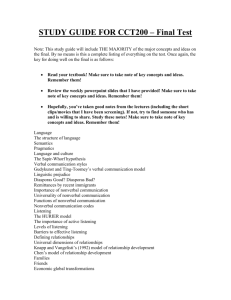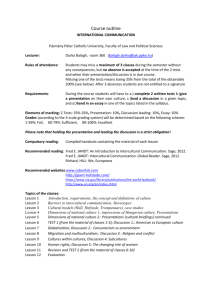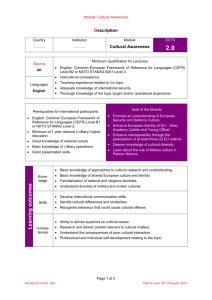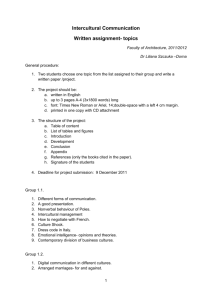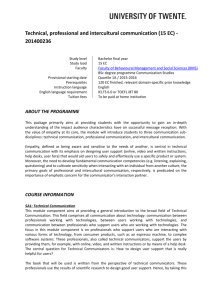Intercultural Speech Communication
advertisement
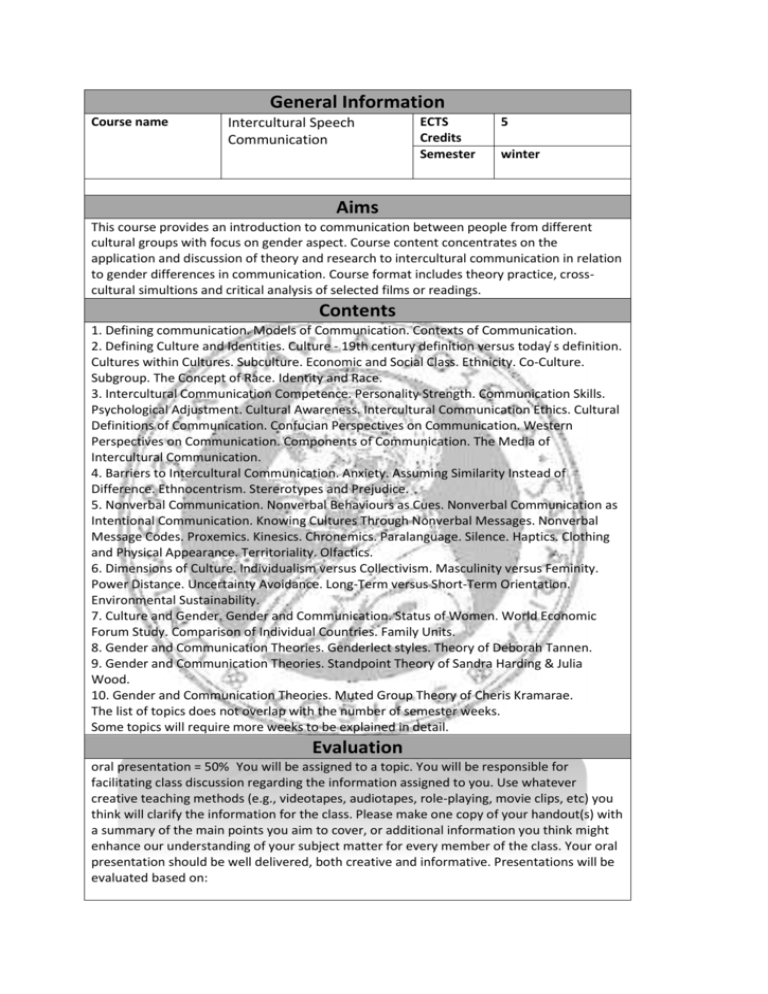
General Information Course name Intercultural Speech Communication ECTS Credits Semester 5 winter Aims This course provides an introduction to communication between people from different cultural groups with focus on gender aspect. Course content concentrates on the application and discussion of theory and research to intercultural communication in relation to gender differences in communication. Course format includes theory practice, crosscultural simultions and critical analysis of selected films or readings. Contents 1. Defining communication. Models of Communication. Contexts of Communication. 2. Defining Culture and Identities. Culture - 19th century definition versus today ś definition. Cultures within Cultures. Subculture. Economic and Social Class. Ethnicity. Co-Culture. Subgroup. The Concept of Race. Identity and Race. 3. Intercultural Communication Competence. Personality Strength. Communication Skills. Psychological Adjustment. Cultural Awareness. Intercultural Communication Ethics. Cultural Definitions of Communication. Confucian Perspectives on Communication. Western Perspectives on Communication. Components of Communication. The Media of Intercultural Communication. 4. Barriers to Intercultural Communication. Anxiety. Assuming Similarity Instead of Difference. Ethnocentrism. Stererotypes and Prejudice. 5. Nonverbal Communication. Nonverbal Behaviours as Cues. Nonverbal Communication as Intentional Communication. Knowing Cultures Through Nonverbal Messages. Nonverbal Message Codes. Proxemics. Kinesics. Chronemics. Paralanguage. Silence. Haptics. Clothing and Physical Appearance. Territoriality. Olfactics. 6. Dimensions of Culture. Individualism versus Collectivism. Masculinity versus Feminity. Power Distance. Uncertainty Avoidance. Long-Term versus Short-Term Orientation. Environmental Sustainability. 7. Culture and Gender. Gender and Communication. Status of Women. World Economic Forum Study. Comparison of Individual Countries. Family Units. 8. Gender and Communication Theories. Genderlect styles. Theory of Deborah Tannen. 9. Gender and Communication Theories. Standpoint Theory of Sandra Harding & Julia Wood. 10. Gender and Communication Theories. Muted Group Theory of Cheris Kramarae. The list of topics does not overlap with the number of semester weeks. Some topics will require more weeks to be explained in detail. Evaluation oral presentation = 50% You will be assigned to a topic. You will be responsible for facilitating class discussion regarding the information assigned to you. Use whatever creative teaching methods (e.g., videotapes, audiotapes, role-playing, movie clips, etc) you think will clarify the information for the class. Please make one copy of your handout(s) with a summary of the main points you aim to cover, or additional information you think might enhance our understanding of your subject matter for every member of the class. Your oral presentation should be well delivered, both creative and informative. Presentations will be evaluated based on: (1) clarity and creativity of your presentation; (2) illustration of intercultural concepts; (3) the substance of your presentation; and (4) your effectiveness of facilitating class involvement and discussion. Written test Final grades will be calculated on the basis of points scored in each evaluation activity = oral presentation (50%) + written test (50%) FINAL EVALUATION : A 93-100% B 86-92% C 7885% D 72-77% E 65-71% FX 64% and less Bibliography Griffin, E. (2006). A first look at communication theory. McGraw-Hill, Inc. NY. Jandt, F. E. (2013). An Introduction to Intercultural Communication: Identities in a Global Community. Sage Publications, Inc. West, R., Turner, H.L. (2000). Introducing Communication theory. Mayfield Publishing Company. London.
